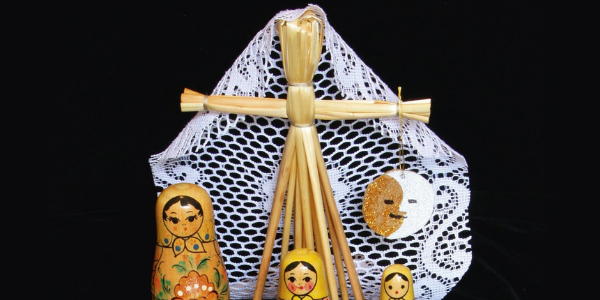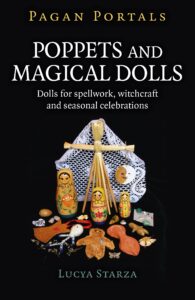
Poppets and Magical Dolls: Dolls for Spellwork, Witchcraft and Seasonal Celebrations, by Lucya Starza
Moon Books, 9781785357213, 128 pp., 2018.
Despite Poppets and Magical Dolls: Dolls for Spellwork, Witchcraft and Seasonal Celebrations being an introductory book in one of the most famous elements of traditional witchcraft, it includes a good amount of detail as well as exercises and projects for the beginner witch to get started in the art of poppet making.
Poppets and Magical Dolls explains how dolls and similar toys are more than just objects of entertainment, and how they can be used in witchcraft. In describing which principles that make this happen, Lucya Starza writes,
Dolls are certainly not just for children. For witches, they can be our companions in magic and protectors of our homes, symbolize the God and Goddess on our altars and be practical tools for casting spells.1
Some parts of this may seem obvious, but the history and folklore behind it reinforce the idea, and this is what makes Poppets and Magical Dolls all the more interesting. Such is the case of the doll in Vasilisa’s story, a Russian folk tale and the origins of the fairies and angels that top a Christmas tree — which I will never look at the same way again, that’s for sure.
Starza doesn’t get lost in details, although she surely gives enough for the reader to do a simple doll, or get creative and try more elaborate methods. From projects with paper that are fast and simple, to a more traditional clay option or even modeling clay as a quick last resort, the author gives plenty of alternatives to use, which I thank her for. Not all witches have good hands for this kind of thing, myself included. I always thought I would have to buy a doll or mannequin or do a second class art project to have a poppet, but Poppets and Magical Dolls taught that nothing is impossible. I have good ideas now, and am eager to try some of them as soon as the right time arises.
In addition to this, the author includes several spells and rituals with different levels of difficulty to help get more familiar with working with poppets, and although this is a serious matter, she has a funny style to explain how this works. She writes,
They aren’t going to sift poppy seeds while you sleep, but asking your doll for help before you go to bed might prompt guiding dreams, leading you to wake the next morning with the answer to a problem in your thoughts or give you the confidence to do what must be done.2
Starza goes as a far as to list colour correspondences with planets and elements, the meaning and uses of numbers, symbols, words, and also herbal mixes to use as fillers for the poppet depending on the purpose of the spell or ritual. It is up to the individual witch how simple or complex the project will be.
The book is also short enough to be read in a single day. I would have preferred the book to be longer, as I always like to go deeper in a subject that interests me, but it goes far enough as an introductory book and includes a lot of detail, so this is just a matter of personal taste.
I will finish saying that you will also get to examine “The Prickly Subject of Pins and Thorns,” which is the title of the fifth chapter, and even curses or dolls for the dead.3These have been subjects of debate not only concerning poppets, but witchcraft in general. She gives enough room to different approaches, while always examining the history and background behind each of them, as well as providing her own point of view. This gives a balance in the options you find in the book and leaves the final word up to the readers themselves.
In short Poppets and Magical Dolls: Dolls for Spellwork, Witchcraft and Seasonal Celebrations provides a responsible approach to the practice. Lucya Starza has done a great job on this book, and I would encourage any witch to read, even if it’s only to get to know the subject. I believe we should learn as much as we can before deciding whether to practice or not, and that’s what Starza asks us to do in her book.









